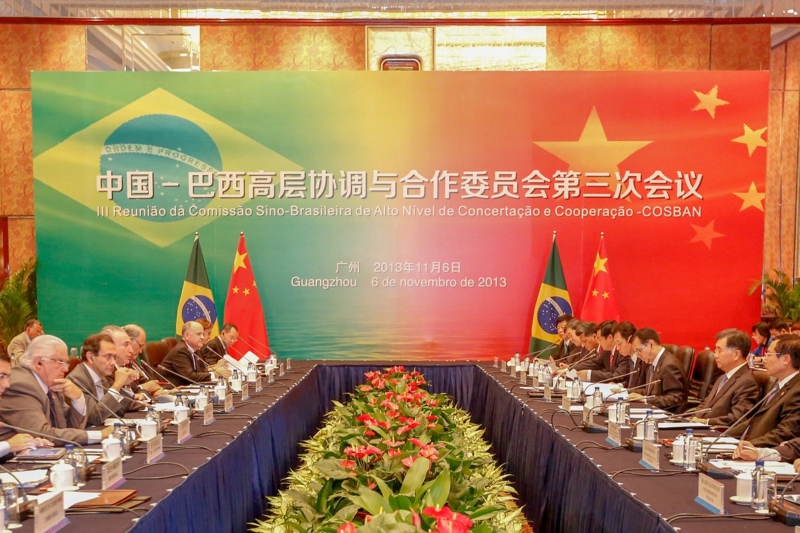The Politics Of Disaster Relief
After a 7.0 magnitude earthquake struck Haiti, the aftershock reached China in ways that few anticipated.The earthquake forced Chinese leaders to navigate the tricky politics of disaster relief.
A Daily Publication of The Dialogue
Brazil and China will restart high-level trade talks later this year with the first meeting of the China-Brazil High-Level Coordination and Cooperation Committee, or Cosban, since 2015, Orlando Leite Ribeiro, the secretary for agribusiness in the foreign ministry, said last month. How has the trade dynamic between Brazil and China changed in recent years, and will trade flows increase significantly in the near future? What implications would stronger trade ties between the countries have for their other trading partners? Where are commodities prices headed this year, and to what extent will they play a role in Brazil-China trade relations?
Andre Soares, counselor for Brazil at the Inter-American Development Bank: “The Brazilian government has hit a home run with the reestablishment of high-level trade talks with China later this year, with the first meeting of the China-Brazil High-Level Coordination and Cooperation Committee (Cosban) in almost four years. I can personally attest to the importance of this meeting in removing bottlenecks from the trade and investment relationship. During the three years that I acted as the research coordinator at the China-Brazil Business Council and was involved in the Cosban meetings, Brazil was able to move forward with a series of market access requests. Cosban is instrumental in addressing business issues because it is the moment when leaders from both countries sit down and negotiate their interests. Business executives deal with different levels of the government on a regular basis, but it is during Cosban that regulatory issues are decided. Examples of success include the opening of the poultry and beef markets (in which Brazilian exports last year amounted to $3.5 billion), agreements between oil companies and agreements to integrate financial markets, with banks being able to open in both countries. During this year’s meeting, it will be interesting to see what will be on the table. Brazil-China relations are set for a restart, and the Brazilian government is at a moment of defining its strategy toward China. Considering the importance of Brazil’s trade balance with China, which hit a record high of $29.5 billion last year, one can expect nothing less than pragmatism on Brazil’s side.”
Margaret Myers, director, and Ricardo Barrios, associate of the Asia & Latin America program at the Inter-American Dialogue: “Trade between Brazil and China has been on the rise in recent years, despite a nearly four-year break in bilateral trade talks. By resuming high-level dialogue on trade, Brazil is aiming not only to promote continued growth trade, but also to diversify the range of goods that it is sending to China. Soy, iron and crude still account for about four-fifths of the value of Brazil’s total exports to China, which amounted to roughly $47 billion in 2017, up almost $10 billion from the year before. China’s exports to Brazil, which rebounded to $27 billion after a drop in 2016, comprise a far wider variety of products, from high-tech telecommunications equipment to motor vehicles. Now is a seemingly opportune moment for Brazil to engage with China on questions of trade. Brazil’s importance to China as a key supplier of commodities has grown over the past couple of years. Amid the U.S.-China trade war, China is increasingly looking to Brazil for a stable supply of much-needed soy. Turbulence in Venezuela could also amount to stronger China-Brazil ties in the oil sector. Beijing already maintains a productive relationship with Brazil’s Petrobras, having provided billions in loans to the oil company over the past decade. Considering the many uncertainties in the trade relationship, such as the prospect for U.S.-China reconciliation and currency fluctuations, both sides could very well benefit from stronger ties.”
Pepe Zhang, associate director for China at the Atlantic Council’s Adrienne Arsht Latin America Center: “Following a consecutive four-year decline, in 2017 bilateral trade between Brazil and China rebounded by 27 percent to $75 billion and continued to expand in 2018. Amid escalating U.S.-China trade tensions, China turned to Brazil as an important alternative source of key commodities, such as soybeans, which traditionally accounted for 40 percent of Brazilian exports to China. With soybeans, beef and other exports recording historic volumes, Brazil boasted $57 billion worth of total exports to China in the first three quarters of 2018. This represents a 24 percent year-onyear growth, as compared to 2017. In the coming months, Brazil will likely witness a continued uptick in exports to China, driven by a combination of two key factors related to the soybean industry: first, the beginning of Brazilian harvest season, and second, improving terms of trade as depressed prices began picking up in December. The medium- to long-term picture, however, will be less clear, as it depends both on the outcome of the U.S.-China trade talks and the capacity of the Brazilian economy going forward. For instance, according to recent UNCTAD estimates, while Brazil was able to capture important export gains caused by U.S.-China trade diversion, a number of other countries have achieved equal or more success in absolute terms, such as Mexico and Canada in the Western Hemisphere, as well as international competitors such as Australia. Ultimately, the extent to which Brazil can successfully sustain and convert the current opportunity into longer-term growth depends on its ability to improve the productivity and competitiveness of its exports and overall economy. In doing so, Brazil may also become better prepared against the eventual and cyclical unwinding of temporary trade windfalls, which, if coupled with unfortunate timing or pace, could bring about sizable reverse trade shocks and inventory problems for Brazilian producers.”
Haibin Niu, senior fellow and deputy director of the Center for American Studies at the Shanghai Institute for International Studies: “Based on its sophisticated and competitive agriculture and mining export sectors, Brazil developed strong trade ties with China in the past decade. Both countries have managed to maintain the trade dynamic based on deep complementarity since China became Brazil’s largest trade partner after surpassing the United States in 2009. Besides the traditional agriproducts such as soy and beef, Brazil might also increasingly supply other meats or dairy products in the near future. Stronger trade ties between China and Brazil serve their interests by providing an alternative market for each other. For example, Brazil’s supply of soy reduced China’s vulnerability amid a trade war with the United States, and China’s demand for poultry might help Brazil, since the Brazilian government’s new position toward its embassy in Israel has hurt poultry exports to Arab countries. Free and institutionalized trade arrangements between China and Brazil also set a good example for their major common trade partners in the Americas, as well as Europe. Commodities prices might be highly uncertain this year. Even global growth will be generally moderate. The optimistic view on commodities prices is based on the Fed’s recent dovish tone and possible Chinese pro-growth stimulus measures. The pessimistic view can also find clues in unresolved trade tension among major world economies, internal and external uncertainties for major energy suppliers, including Venezuela and Iran, as well as the increasing challenges the World Trade Organization is facing. This uncertainty makes trade ties between China and Brazil more valuable for the two countries.”
 The Latin America Advisor features Q&A with leaders in politics, economics, and finance every business day. The publication is available to members of the Dialogue’s Corporate Program and others by subscription.
The Latin America Advisor features Q&A with leaders in politics, economics, and finance every business day. The publication is available to members of the Dialogue’s Corporate Program and others by subscription.
After a 7.0 magnitude earthquake struck Haiti, the aftershock reached China in ways that few anticipated.The earthquake forced Chinese leaders to navigate the tricky politics of disaster relief.
What should we expect from a newly powerful Brazil? Does the country have the capacity and leadership to be a central actor in addressing critical global and regional problems?
2009 has not been a good year for U.S.-Latin America relations. Despite their warm welcome at the April Summit, Latin America’s governments made life more difficult than anticipated for President Obama.
